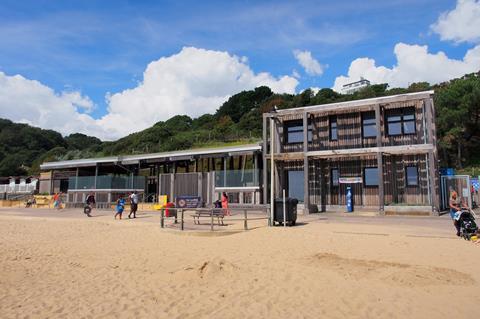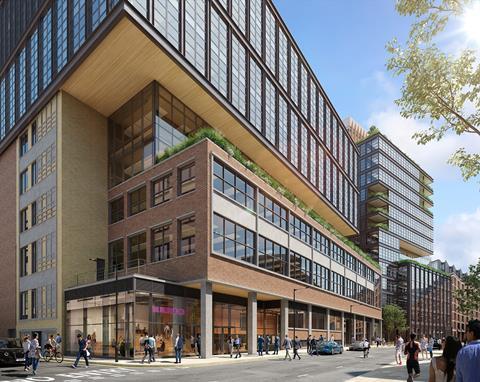David Partridge has been tasked with bringing together construction’s many and varied definitions of net zero. He tells Thomas Lane why setting a recognised and easily understood benchmark for whole-life carbon emissions is so important

David Partridge shows me a slide to demonstrate why the industry needs another net zero carbon buildings standard (NZCBS). The slide has 15 different industry definitions of net zero.
There is LETI’s climate emergency design guide, the RICS whole life carbon assessment for the built environment, guidance for a net zero National Health Service, the RIBA 2030 climate challenge, NABERS and the UKGBC’s NZC building verification to name a few.
“I was speaking to an architect at one of our engagement sessions who said he spent the first six months of any discussion with clients understanding what their definition of net zero was before he could even begin designing the building,” Partridge, the chair of developer Related Argent, says.
The problem with this proliferation of net zero carbon definitions is that they are all tackling different aspects of the same thing. NABERS only covers operational carbon, RICS is a whole-life carbon assessment methodology but does not include any targets, RIBA and LETI have targets but these only cover residential, office, retail and education.

>> Also read: What the future homes standard means for net zero
>> Also read: ��ɫ����TV the future commission: Nabers – the energy ratings system that goes further than part l
Partridge says the industry is “crying out” for a single standard that covers embodied and operational carbon and applies to all building types. This is why he has opted to chair the group developing the UK net zero carbon building standard which aims to develop that unified measure.
It’s really important that we should reach across all the various different elements of the real estate industry to ensure that this is something that isn’t just an academic exercise
Committed to energy efficiency even in the days before the link between burning fossil fuels and climate change was generally recognised, Partridge, who trained as an architect, has always sought to design and develop buildings that minimise energy use. A trustee of UKGBC since 2017, as joint chief executive of Argent he oversaw the introduction of a district heating system at the Kings Cross development that bettered building energy regulations by 20% back in 2006 when such a concept was almost unheard of.
For Partridge, ensuring the standard is embraced by the industry is another key reason why he got involved. “It’s really important that we should reach across all the various different elements of the real estate industry to ensure that this is something that isn’t just an academic exercise put together by practitioners, but universally accepted and adopted,” he says.
“I think the reason why I was chosen [as chair] was because I was someone who understood and had contacts with the real estate industry; the funders, the building owners and developers and the contracting side too.”
What is the net zero carbon buildings standard?
The standard is supported by most of the institutions on Partridge’s industry guidance slide. These include LETI, RIBA, RICS, CIBSE, BRE and UKGBC. The standard is also sponsored by developers including British Land, Landsec, Derwent, Crown Estate, and GPE. Mace is a sponsor and the engineer Introba too.
That institutional backing is crucial, not just for the expertise needed to develop the standard but because the institutions have agreed to adopt the standard when they next update their own guidance with the idea this becomes universal.

Partridge describes the NZCBS as a single methodology for first measuring, then robustly verifying the net zero carbon impact of buildings. He likens it to a set of rules and says it will be written almost like an international standard and will be clear, consistent and easy to use.
There will be targets for 13 different building types including healthcare, cultural, hotels, heritage buildings and data centres. There will be two main categories, new build and retrofit of existing buildings and achieving the standard will be ‘stretching but achievable.’ The standard will be awarded once a year’s worth of operational data becomes available.
Partridge says feedback from the industry strongly supports some form of in progress check at practical completion so the standard may allow for embodied carbon validation at this stage and recognition that the building is on track to meet operational carbon targets. NABERS certification requires a year’s worth of operational data so discussions are taking place to determine whether achieving a certain NABERS rating will qualify for NZCBS verification.
How is the standard being determined?
Developing the standard is a huge undertaking, with over 350 experts from across the industry taking part in a variety of groups that determine the targets and limits and provide expertise on the decarbonisation challenges of specific sectors and what targets might be realistic.
The standard recognises that constructing and operating buildings inevitably emits some carbon. The standard is based on scientific principles by setting out to align the carbon emitted by the built environment to that in the 2015 Paris Agreement, which aims to limit global temperature rises to below 1.5°C.
The standard is based on a combination of two approaches: top down and bottom up. The Climate Change Committee’s sixth carbon budget and the National Grid ESO’s Future Energy Scenarios carbon budget have been used to determine this country’s built environment’s share of the UK’s contribution to the global carbon allowance.
The top-down approach allocates a percentage of those emissions to the built environment with a carbon budget allocated to each of the 13 different building types. The bottom-up approach takes benchmarking and operational data from 3,500 projects and embodied carbon data from 800 projects to determine performance levels for each building type. Data from the top-down and bottom-up approaches is combined to determine the carbon limits for each of the 13 sectors and from that targets for individual buildings within those sectors.
This is quite groundbreaking as there is nowhere else in the world that is taking this approach
The standard recognises that it might be very difficult for carbon intensive sectors such as healthcare or data centres to keep within the carbon budget for those building types, and relatively easy for others, for example logistics facilities. The former will potentially get more relaxed and the latter tougher carbon limits. The goal is to keep the total contribution from all 13 building types below the UK built environment’s carbon budget.
“We think this standard is far more useful than some of the international ones which just take a single [carbon] number for real estate and say you’ve got to stay within that limit, regardless of whether this is a hospital, a single flat, a shop or a warehouse,” Partridge explains.
“The [NZCBS] methodology is so much more applicable to real estate in general because there is such a disparate set of building typologies and activities that go on within these. This is quite groundbreaking as there is nowhere else in the world that is taking this approach.”
What does the industry think about the standard?
A key part of Partridge’s role is engaging the industry with the standard to ensure that it will be widely adopted. He has spent the past four months touring the country to present the proposals to a cross-section of industry people to raise awareness of the standard and discover what needs to be tweaked for them to adopt it.
We’ve got a huge groundswell of interest and momentum behind it
“I feel the whole industry is coming together behind the standard and is eager to hear what the final limits look like and how they can begin to start applying it to their own activities, whether that’s informing lending, refurbishment, design and occupational decisions,” he explains. “We’ve got a huge groundswell of interest and momentum behind it.”
Part of the feedback loop is the decision to offer some form of validation at practical completion. It also includes a decision not to mandate carbon offsetting of the emissions from constructing a building. The standard will apply to entire buildings but some sectors – notably office developers – want a delineation between tenant and landlord emissions which will be introduced into future iterations of the standard.
When will it be introduced?
The NZCBS limits are being finalised with the objective of publishing a beta version of the standard in the summer. The standard will be tested during the rest of this year and a final version published along with accompanying guidance and verification disclosure templates with the idea that all construction disciplines report their data in a standardised way.
Longer term, Partridge says the standard will need to be updated periodically, for example if the climate change committee updates the carbon budgets, or in response to better performance data or where sectors have made significant carbon reductions and could cope with tougher targets. He adds that not only have the industry and professional institutions aligned behind the standard but there have been conversations with local and combined authorities about using the standard as the reference for net zero planning or public sector procurement requirements.

There have been calls from many in the industry for the government to regulate embodied and whole-life carbon, including the development of Part Z which was drawn up as a possible building regulation. Partridge says the government is not currently in a state where it could adopt Part Z or the NZCBS. But he has presented the standard to government ministers – and politicians in the Labour Party too – and the feedback has been that there would be no point reinventing the NZCBS given the work that has gone into it, and should it be widely adopted.
“By then [the general election], we will have a standard that has been published and hopefully being adopted by vast swathes of the industry,” Partridge says. “It should be relatively easy for them to point to it and say, if we are going to legislate, let’s reference this because it is the benchmark.”



























No comments yet